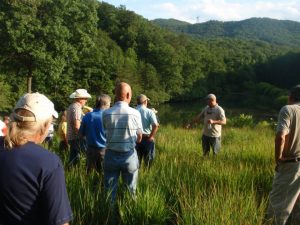Our “quail team” has now marked 10 years in service to the Commonwealth’s private landowners, who are the key to achieving long term conservation goals. Our entire team thanks all of Virginia’s wildlife habitat-minded landowners who have assisted in the quest to make Virginia a better place for quail, monarchs, native bees, and songbirds. I’d also like to share my deeply felt thanks and goodwill to all 11 of the private lands wildlife biologists who have given a substantial part of their lives to wildlife conservation in the last decade—most especially Andy Rosenberger, who is our sole remaining original private lands wildlife biologist, and whose mentorship to the entire team over the years has contributed immeasurably to our success. Thanks also to the dozens of agency, NGO, and other partners we have worked with. We joined forces with them to conserve and increase Virginia’s early-successional wildlife. We’ll elaborate a great deal more on this in our 10-Year Milestone Edition of the Bobwhite Bulletin which will be printed and available this spring for all our partners.
[table “” not found /]The numbers above only tell the technical story. Our team, or family as we sometimes feel, has undergone all of the trials of life common to human existence as we labored diligently on the good days and the bad to bring the best habitat technical assistance to Virginia’s landowners as we knew how. The “stats” never tell the whole story. Our team has represented the Department of Game and Inland Fisheries (DGIF), the Natural Resources Conservation Service, and the Conservation Management Institute at Virginia Tech to the very highest level.
I also want to mention that our team has not limited our work to private lands. We have helped DGIF and many partners with public lands habitat management planning, implementation, and education, including assisting on prescribed fire crews whenever we can. I do almost all my hunting and fishing on public lands and have nothing but the greatest respect and admiration for those who work on our publically accessible lands. In the case of DGIF, our wildlife area managers continue to do a phenomenal job on our 44 Wildlife Management Areas (WMA) with a relatively small staff.
The synergy between public and private lands conservation is critical to the 21st century’s wildlife.
In the case of our private lands team, our goal was to ensure that we developed a program where our biologists could truly focus on the private landowner. First and foremost, our goal has been to become increasingly adept at providing the best technical assistance and habitat management advice possible. And not just for quail, but for any of the goals a landowner may have in mind for multiple wildlife species.
We have also tried to continue to simplify the financial incentives program sign-up process for them. All this involves continual training and professional development. With over 80% of Virginia in private ownership, this investment just makes sense. And while we were working on our own improvement, the things we learned have also helped our public lands biologists. Cross training is imperative. We all learned, and continue to learn, from each other. New information on how to establish pollinator plantings, how to control non-native invasive plants, how to combine quail management techniques, and how to monitor species through time benefit everyone on all lands regardless of where they were developed. And as always, we keep up with the latest trends in quail management from the entities that are the tip of the spear with regards to quail research.

Our public lands are also developing. The value of our WMAs as public educational tools is an aspect I think we have yet to fully tap into. Our staff, whether private or public lands oriented, continue to improve and seek professional development. That is the mark of a true professional, the desire to continue to improve and take ownership in making it happen. Our agency’s ability to conduct prescribed fire, and the skill with which we apply it, has improved markedly over the last decade and continues to improve. The technical resources we provide staff and landowners has also improved (witness the latest in “Beyond the Bonfire,” https://www.vafirecouncil.com/).
Our team’s hope is that over the next decade, our public and private lands managers will cross pollinate more and more, and our WMAs will become increasingly utilized for public and partner habitat management education. Our public lands should be flagships for conservation practices, whether they be new practices and management methods, or practical applications of tried techniques used to correct some of our past mistakes, which we have made over the years. Most important in my mind is the fact that the more understanding and acceptance we have among Virginia’s private landowners about the management techniques we use, the more acceptance and understanding we’ll also have from them concerning the management of our agency lands. This will become increasingly important as our agency lands come closer and closer to the suburban/wildland interface.


